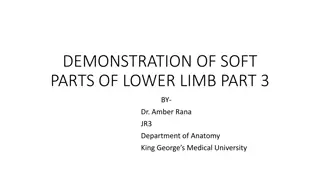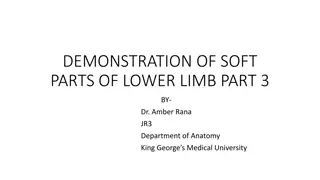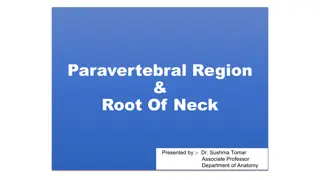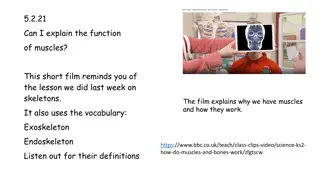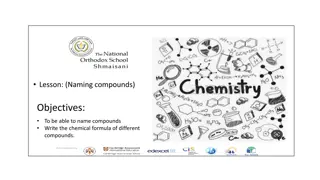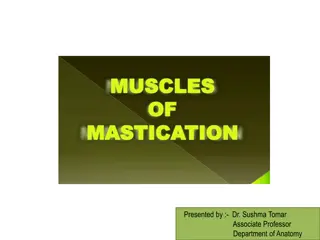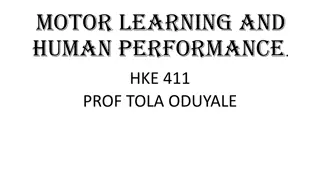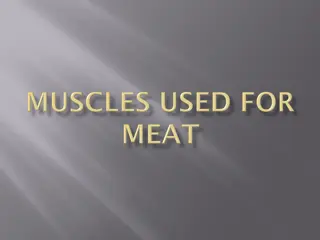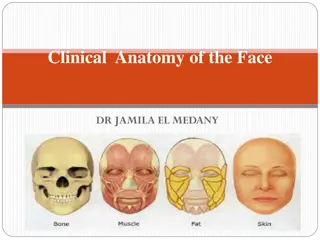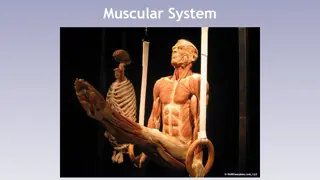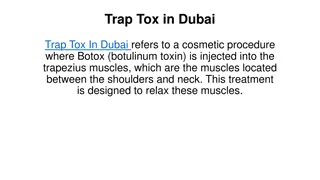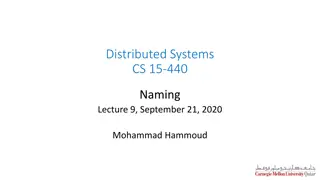
Muscles: Origins, Insertions, and Naming Conventions
Explore the fundamentals of muscle anatomy, including origins and insertions, prime movers and synergists, Latin and Greek roots used to name muscles, and characteristics such as direction, size, and location. Discover the significance of terms like Rectus, Longus, Maximus, and more. Enhance your knowledge of muscle structure and function.
Download Presentation

Please find below an Image/Link to download the presentation.
The content on the website is provided AS IS for your information and personal use only. It may not be sold, licensed, or shared on other websites without obtaining consent from the author. If you encounter any issues during the download, it is possible that the publisher has removed the file from their server.
You are allowed to download the files provided on this website for personal or commercial use, subject to the condition that they are used lawfully. All files are the property of their respective owners.
The content on the website is provided AS IS for your information and personal use only. It may not be sold, licensed, or shared on other websites without obtaining consent from the author.
E N D
Presentation Transcript
Origin: the immovable end of the muscle; attached to a relatively immovable bone Insertion: the end of the muscle attached to a movable bone **When a muscle contracts, its insertion is pulled toward its origin.
Prime mover (agonist): the muscle that provides most of the movement in an action Synergists (antagonists): the muscles around the prime mover that assist it in an action
Prime Mover Synergist
Latin and Greek roots Characteristics Used to Name Muscles 1) direction of their fibers 2) size 3) location 4) which bones they attach to 5) function **The names of muscles often contain combinations of each of the above.
Determined in relation to the midline of the body Rectus: (Latin for straight ) Parallel to the midline Ex: rectus femoris and rectus abdominis Oblique: at an angle to the midline Ex: internal and external obliques of the thorax
Longus: long Brevis: short Maximus: largest or greatest Major: larger Vastus: huge Minimus: least or smallest Minor: smaller
Oris: mouth Oculi: eye Palmaris: palm of the hand Abdominus: abdomen Brachii: arm Femoris: thigh Tibialis: shin bone Peroneus: fibula Digitorum: finger or toe Pollicis: thumb Costals: rib Hallicus: great toe Carpi: wrist Spinalis: spine Scapularis: shoulder blade
Spinalis thoracis Biceps brachii Rectus femoris Adductor pollicis longus
Orbicularis oculi External intercostals Tibialis anterior Peroneus longus
Many muscles are named as a result of their association with a particular bone. The temporalis muscle is found covering the temporal bone. The frontalis muscle is found covering the frontal bone of the skull.
Some muscles are named for their origin and insertion. The first part of the muscle name indicates the origin, while the second part of the name indicates the insertion. Ex: sternocleidomastoid = sterno (breastbone) and cleido (clavicle) insertion; mastoid (breast shaped) process on the skull
Some muscles have multiple origins. This number will often be used in the name. Ex: biceps brachii and triceps brachii Bi is Latin for two Tri is Latin for three Ceps refers to the head So the biceps brachii has two heads that attach to two different origins.
In addition to having the name of the bone in the muscle name, the position in relation to the bone or body part may be in the muscle name.
Supra: above or over Infra: below or beneath Sub: below or under Lateralis: the side Medialis: the middle Inter: between or among External: outer Internal: inner
Superior: above or over Inferior: underneath Dorsi: the back Anterior: in front of Ex: supraspinatus, infraspinatus, subscapularis, vastus lateralis, vastus medialis, intercostals, external internal obliques, superior and inferior rectus of the eye
Early anatomists often named muscles after the shapes they resembled. Deltoid: delta = triangle; oid = like Trapezius: trapez = table Serratus: saw Teres: round Orbicularis: orbi = circle, cul = little Latissimus: lat = broad/wide, simus = like
Deltoid= = Serratus = =
What would the following muscles look like and where would they be found? Latissimus dorsi Orbicularis oculi Orbicularis oris
flexion : flex = bend (decreases the angle at a joint) extension: ex = out; ten = stretch (increases the angle at a joint) adduction:ad = toward; duct = lead (pulls the limb toward the midline) abduction : ab = away from; duct = lead (pulls the limb away from the midline) pronation: pron = bent forward (turning the palm downward) supination: supin = lying on the back (turning the palm upward)
EX) Flexor carpi radialis is a muscle of the human forearm that acts to flex and (radial) abduct the hand. EX) Extensor digitorum is a muscle that extends the medial four digits of the hand.


